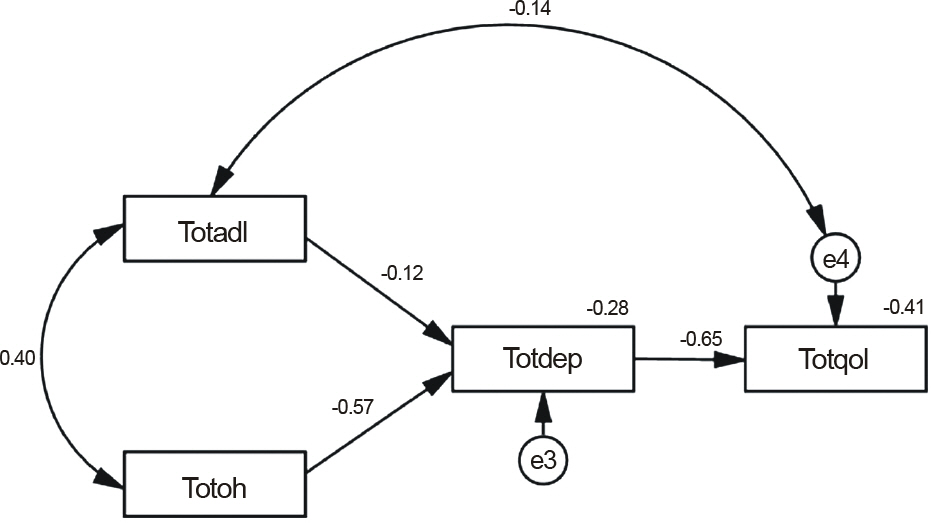References
1. Kang SY, Park IH. Construction of a model of quality of life in longevity region dwelling elders. J Korean Acad Community Health Nurs 2013;24(3):302–13.
2. Kim HK, Lee HJ, Park SM. Factors influencing quality of life in elderly women living alone. J Korean Gerontol Soc 2010;30(2):279–92.
3. Lin QL, Kim HK, Ann JS. Relationship between depression and quality of life in elderly women living alone: the moderating and mediating effect of social support and social activity. J Korean Gerontol Soc 2011;31(1):33–47.
4. Nam KM, Jung EK. The influence of social activity and social support perceived by elderly women living alone on their quality of life: focusing on the mediating effect of depression and death-anxiety. J Welf Aged 2011;52:325–48.
5. Ministry of Health & Welfare, Korean Centers for Disease Control & Prevention. Korea Health Statistics 2012: Korea National Health & Nutrition Examination Survey (KNHANES V-3) [Internet] Seoul: Ministry of Health & Welfare; 2013. [Accessed July 4 2014]. http://www.bokjiro.go.kr/data/statusViewdo?board_sid=297&data_sid=6129473&pageIndex=1&pageUnit=10&searchSort=REG_DESC.
6. Lee KE, Yom YH, Kim SS, Han JH. Gender differences in oral health literacy related factors among elderly people. J Korean Acad Community Health Nurs 2014;25(1):54–64.
7. Koshino H, Hirai T, Ishijima T, Tsukagoshi H, Ishigami T, Tanaka Y. Quality of life and masticatory function in denture wearers. J Oral Rehabil 2006;33(5):323–9.
8. Yamaga E, Sato Y, Minakuchi S. A structural equation model relating oral condition, denture quality, chewing ability, satisfaction, and oral health-related quality of life in complete denture wearers. J Dent 2013;41(8):710–7.
9. Jensen PM, Saunders RL, Thierer T, Friedman B. Factors associated with oral health–related quality of life in community-dwelling elderly persons with disabilities. J Am Geriatr Soc 2008;56(4):711–7.
10. Slade GD. Assessing change in quality of life using the Oral Health Impact Profile. Community Dent Oral Epidemiol 1998;26(1):52–61.
11. Back JU. The effect of oral health on total health and quality of life between Korean and Japanese. Korean Public Health Res 2012;38(1):81–98.
12. Park MS, Choi-Kwon S. The effects of oral care education on caregivers'knowledge, attitude, & behavior toward oral hygiene for elderly residents in a nursing home. J Korean Acad Nurs 2011;41(5):684–93.
13. Han JH, Yom YH. Effects of eating habits, activities of daily living and health behaviors on oral health related-quality of life in elderly persons. J Korean Acad Fundam Nurs 2012;19(2):179–89.
14. Lee GR. The impact of DMFT index on oral health related quality of life in community-dwelling elderly. J Korean Acad Dent Health 2008;32(3):396–404.
15. Park JR, Kim HJ. The effect of need of oral health management to oral health impact profile among elderly over 65 years. J Korean Soc Dent Hyg 2011;11(6):961–71.
16. Yoon HS. Influence of oral health status on oral health related quality of life (OHIP-14) among elderly people in Busan. J Korean Soc Dent Hyg 2013;13(5):759–67.
17. Lee HS, Kim CM. Effect of oral health impact profile (OHIP) on depression and quality of life among community-dwelling Korean elderly persons. J Korean Acad Community Health Nurs 2012;23(3):338–46.
18. Slade GD. Derivation and validation of a short-form oral health impact profile. Community Dent Oral Epidemiol 1997;25(4):284–90.
19. Won CW. Korea activities of daily living scale and Korea instrumental activities of daily living scale. J Korean Geriatr Soc 2002;6(1):1–10.
20. Sheikh JI, Yesavage JA. 9/Geriatric depression scale (GDS): recent evidence and development of a shorter violence. Clin Gerontol 1986;5(1–2):165–73.
21. Lee HS, Kim DG, Ko HJ, Ku HM, Kwon UJ, Kim JH. The standardization of 「geriatric quality of life scale」. Korean J Clin Psychol 2003;22(4):859–81.
22. Miura H, Yamasaki K, Morizaki N, Moriya S, Sumi Y. Factors influencing oral health-related quality of life (OHRQoL) among the frail elderly residing in the community with their family. Arch Gerontol Geriatr 2010;51(3):e62–5.
23. CatovićA. Bergman V, CatićA . Qualitative evaluation of elderly home residents' fixed and removable prostheses in relation to the ADL index. J Dent 2003;31(1):3–8.
24. Naito M, Kato T, Fujii W, Ozeki M, Yokoyama M, Hamajima N, et al. Effects of dental treatment on the quality of life and activities of daily living in institutionalized elderly in Japan. Arch Gerontol Geriatr 2010;50(1):65–8.
25. Hassel AJ, Danner D, Freier K, Hofele C, Becker-Bikowski K, Engel M. Oral health-related quality of life and depression/anxi-ety in longterm recurrence-free patients after treatment for advanced oral squamous cell cancer. J Craniomaxillofac Surg 2012;40(4):e99–102.
26. Ingram SS, Seo PH, Sloane R, Francis T, Clipp EC, Doyle ME, et al. The association between oral health and general health and quality of life in older male cancer patients. J Am Geriatr Soc 2005;53(9):1504–9.
27. Nam YS, Jang JY. Potential factors associated with the quality of life in South Korean senior people: based on oral health. J Dent Hyg Sci 2013;13(3):281–9.
28. Shin SI, Kim YH. A metaanalysis on related variables of elder's quality of life. Korean J Couns 2013;14(6):3673–90.
29. Chung YH, Cho YH. Health behaviors, health status and quality of life among the young-old and the old-old in Korea. Korean Public Health Res 2014;40(1):55–64.
30. Kim JS. The value in quality of life and recognition and preferences for advance directives by the elderly's age. J Korean Gerontol Soc 2012;32(1):1–23.




